

Perform ADPG cluster tuning
The Tuning page allows you to calculate PostgreSQL parameter values based on the configuration of cluster nodes and the purpose of using the cluster.

|
IMPORTANT
Note that calculated values reflect general guidelines on configuration of PostgreSQL parameters and can be used as a starting point. Optimal parameter values depend on the load of a particular cluster and used hardware. |
At the top of the page, you can choose how the parameters are calculated:
-
ADPG parameters — for the leader node of the current cluster;
-
Custom parameters — according to the specified characteristics.

The Custom parameters option is useful if a replica node has characteristics different from the leader, and the optimal parameter values for it may vary. In this case, after calculation, you can use the Custom postgresql.conf field from the ADPG Configurations section of the ADPG service configuration to set different parameter values using ADCM config groups.
After you select the type of tuning, set cluster characteristics based on which ADPG Control calculates the parameters. Characteristics are listed in the table below. They are divided into two groups: Database and Server.
If the ADPG parameters option is selected, most part of the parameters are filled automatically according to leader node configuration and cannot be changed. Only the Application profile and Storage type parameters are available for editing.

| Group | Name | Description | Default value |
|---|---|---|---|
Database |
Application profile |
An application load profile. The following values are possible:
|
General web applications |
PostgreSQL version |
Major version of PostgreSQL |
16 |
|
Server |
Storage type |
The storage type. The possible values:
|
SSD Storage |
Operating system |
The type of operating system. The possible values:
|
GNU/Linux based |
|
Architecture |
The server architecture. The possible values:
|
64 Bits (x86-64) |
|
Number of CPUs |
The number of CPUs |
2 |
|
Total memory |
The amount of server RAM |
4gb |
|
Max connections |
The expected number of connections |
100 |
The calculated parameters are displayed in the window at the bottom of the page.

When the Custom parameters option is selected, ADPG Control calculates the following parameters:
If the ADPG parameters option is used, ADPG Control takes the content of the postgresql.conf field from the ADPG Configurations configuration section of the ADPG service and adds the parameters listed above to it. If a parameter has already been specified in the postgresql.conf field, its value is changed to the optimal one.
To copy the parameters, click Copy to clipboard. You can replace the postgresql.conf field value with the copied text or pasted it into the Custom postgresql.conf field of ADPG cluster settings in ADCM UI.
